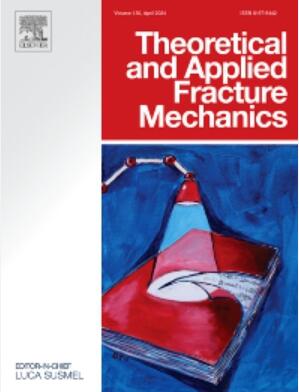研究激光粉末床熔融 Ti6Al4V 合金疲劳性能中的单个熔融缺失缺陷:有限元分析
IF 5
2区 工程技术
Q1 ENGINEERING, MECHANICAL
引用次数: 0
摘要
激光粉末床熔融(L-PBF)技术为各行各业的 Ti6Al4V 合金生产带来了革命性的变化。然而,L-PBF Ti6Al4V 合金的疲劳性能不佳,尤其是在高循环情况下,阻碍了其广泛应用。造成这种限制的一个重要因素是 L-PBF 工艺固有的内部缺陷,这些缺陷是疲劳裂纹的起始点。以前的研究主要集中在具有气孔的 L-PBF Ti6Al4V 合金的疲劳性能上,而对公认为最有害缺陷的熔合不足(LOF)的研究仍然有限。为了加深我们对 L-PBF Ti6Al4V 合金中观察到的与固有 LOF 相关的疲劳性能降低的影响因素的理解,本研究采用了三维(3D)有限元分析方法。这种方法可以评估疲劳指标参数,从而评估疲劳寿命和预测疲劳裂纹扩展。研究人员提出了一种三维平均 Smith-Watson-Topper 方法,该方法能够合理估算 L-PBF Ti6Al4V 的疲劳寿命。此外,还开发了一种新颖的有限元方法,用于精确计算嵌入 LOF 的凹口状特征的不规则形状裂纹前沿的应力强度因子。此外,还进行了参数研究,以进一步了解 LOF 对疲劳性能的影响。结果表明,嵌入式驼峰和凹口状特征的存在及其拓扑结构对以 LOF 为主的 L-PBF Ti6Al4V 合金的疲劳性能起着关键作用。本文章由计算机程序翻译,如有差异,请以英文原文为准。
Investigation of individual lack-of-fusion defects in the fatigue performance of laser-powder bed fusion Ti6Al4V alloys: A finite element analysis
Laser-Powder Bed Fusion (L-PBF) techniques have revolutionized the production of Ti6Al4V alloys across various industries. However, the widespread adoption of L-PBF Ti6Al4V alloys is impeded by their inadequate fatigue performance, particularly in high cycle regimes. A significant contributing factor to this limitation is the presence of internal defects inherent to the L-PBF process, act as sites for fatigue crack initiation. Previous investigations have focused on the fatigue performance of L-PBF Ti6Al4V alloys with gas porosities, while research on lack-of-fusions (LOFs) which are recognized as the most detrimental defects, remains limited. In order to deepen our understanding of the factors influencing the reduced fatigue performance observed in L-PBF Ti6Al4V alloys associated with inherent LOFs, this study employed three-dimensional (3D) finite element analysis approaches. Such approaches allow to assess fatigue indicator parameters to evaluate fatigue life and predict fatigue crack propagation. A 3D average Smith-Watson-Topper method has been proposed, which is able to rationally estimate the fatigue life of L-PBF Ti6Al4V. In addition, a novel finite element method has been developed to accurately calculate stress intensity factors along irregular shaped crack front of a notch-like feature embedded on a LOF. Additionally, parametric studies were conducted to gain further insights into the influence of LOFs on fatigue performance. The results shown the presence of embedded humps and notch-like features, and their topologies play key roles in the fatigue performance of LOF predominated L-PBF Ti6Al4V alloys.
求助全文
通过发布文献求助,成功后即可免费获取论文全文。
去求助
来源期刊

Theoretical and Applied Fracture Mechanics
工程技术-工程:机械
CiteScore
8.40
自引率
18.90%
发文量
435
审稿时长
37 days
期刊介绍:
Theoretical and Applied Fracture Mechanics'' aims & scopes have been re-designed to cover both the theoretical, applied, and numerical aspects associated with those cracking related phenomena taking place, at a micro-, meso-, and macroscopic level, in materials/components/structures of any kind.
The journal aims to cover the cracking/mechanical behaviour of materials/components/structures in those situations involving both time-independent and time-dependent system of external forces/moments (such as, for instance, quasi-static, impulsive, impact, blasting, creep, contact, and fatigue loading). Since, under the above circumstances, the mechanical behaviour of cracked materials/components/structures is also affected by the environmental conditions, the journal would consider also those theoretical/experimental research works investigating the effect of external variables such as, for instance, the effect of corrosive environments as well as of high/low-temperature.
 求助内容:
求助内容: 应助结果提醒方式:
应助结果提醒方式:


